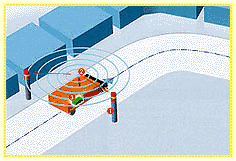Wire guidance (inductive guidance) is a dependable and accurate active guidance method for manual and automatic vehicles. Features include precision electronics and antenna to determine the exact location of the signal center, measuring hight, side, and angle from the embedded wire carrying the frequency.
Wire guidance allows the vehicle to acquire the guide path, steering the vehicle toward the wire automatically from angles up to 70 degrees. Suitable for all vehicles requiring precise position orientation (skew) or traveling at greater speeds.
Magnetic Navigation is employed when the following criteria are met:

![]()
Laser Navigation is employed when the following conditions exist:

Rail Guidance is for manually operated vehicles only. Trucks are fitted with guide rollers which engage rails installed at a specified width for the intended vehicle. This form of guidance generally required the loads to be placed above the floor level.
